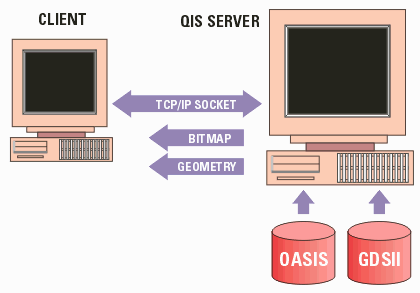The Qckvu Image Server [QIS] is a powerful GDSII/OASIS database server that enables a client software to display and manipulate GDSII/OASIS data using a simple API.
As GDSII and OASIS files grow larger, many software developers are discovering that their own GDSII routines are no longer able to deal effectively with these large files -- they face the need to completely rewrite GDSII readers to handle files of 10,20 and even 50 GB.
QIS can be used as a "server" and eliminates the need to deal with the problems associated with opening and randomly accessing such large files. The OEM can focus on core expertise and treat QIS as a GDSII/OASIS library.

Basic Functionality
Commands are sent from the "client" to QIS via a TCP/IP socket. [Note: there is now a shared library version of QIS for applications where a TCP/IP interface is not needed] The client can request data such as a list of layers or structures and can at any time request an "image" or geometries - the image is ideal for display and geometries are useful for data processing.
The client can also send "state" commands such as turning layers on and off, assigning fill patterns to layers and changing the display window size, coordinates and magnification.
Client & Server Unlinked
The use of simple commands together with a TCP/IP based API separates the client's operating system and source code from the server. In principle, it should be possible to open and view a 50 GB GDSII file on your Palm Pilot®!
Additional Operations
In addition to enabling remote viewing, QIS includes several other functions useful for OEM applications:
geometry extraction one can request all the geometries in a region; The client software can then do operations on the geometries such as mask correction.
high resolution rasterization - a special high resolution rasterization can return large raster files with DPI's of 100,000 to 250,000. Ideal for comparing metrology data captured by cameras to the CAD data.
database editing - QIS can be used to add or delete geometries from very large databases.
extraction by net - QIS has a companion server called NetTrace that can extract all geometries that are "electrically connected" Ideal for certain metrology applications and for parasitic simulation or power density simulations.
View Only - QIS can read a GDSII file, convert the file into its internal memory map representation and save this data to disk. The data can be transferred to another user, allowing that user to view the data but not have access to the original GDSII data. This provides a high level of security for users who need to review the data in detail but who must not be able to save or otherwise use the data. Details
These additional functions make QIS much more than just an imaging tool.
|
Speed Up File Opening Very large GDSII files can take a long time to initially open because there is a lot of data to scan, organize a quad tree (for fast pan/zoom) and load into memory. This initial load time can be greatly reduced by "off line" processing. Off line processing occurs when QIS does the scanning and quadtree building separately and stores the results on disk -- thus enabling one to open a large file later on for viewing in seconds. This feature is of special interest to OEMs of mask and wafer inspection equipment. Details ... |
New QIS Client Library Several users have asked if QIS is available as a library instead of accessing it through TCP/IP. Converting QIS to a library is a very large task -- we have developed a library that our customers can use; the customer's application calls the library which in turn handles the TCP/IP communication with QIS. Details ... |
